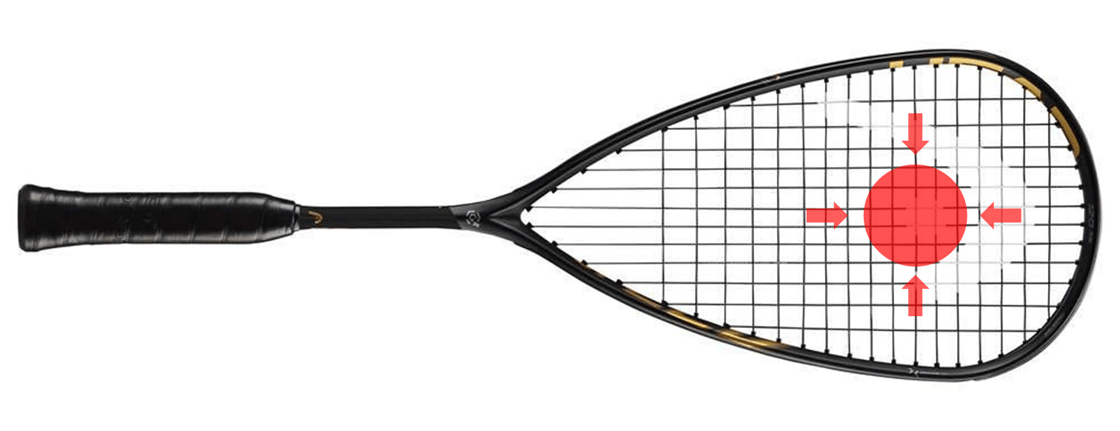I recently wrote an article about my experience of returning to squash after 6 months off court. I'm sure you'll all be thrilled to hear that I'm much less sore after matches now and my movement is almost back up to scratch.
However, something I've noticed that I'm still struggling with is consistently hitting the sweet spot. For those of you who don't know, the sweet spot is a central location on the string bed that is the ideal point of contact when you hit the ball.
When you hit the ball at the sweet spot, it essentially gives you the best chance of hitting a controlled shot with the most optimised power return from the energy you put into the swing.
Anyway, I know this is a problem many players struggle with and, since I've been dissecting my game and thinking about why I might be struggling to hit the sweet spot recently, I thought I'd share my tips/thoughts/discoveries in another article.
So, here are 4 reasons why you might not be hitting the sweet spot...
1. Poor Racquet Preparation
Getting your racquet up as early as possible is essential when it comes to hitting a clean ball.
If your racquet prep is too low, too slow, or even too large, it can make it far more difficult to hit that sweet spot with consistency.
Let's say you're opponent hits a weak boast that comes back into the middle of the court, this is a prime opportunity to either win the rally or put your opponent in another tough position.
If you approach that ball with your racquet still low down by your side, only to then lift your racquet up and swing through very late (or even try to flick your shot with no backswing at all), the whole shot becomes very frantic and rushed, minimising your chances of hitting the sweet spot and an accurate shot too.
Alternatively, I've seen players whose racquet preparation is far too high and exaggerated. You shouldn't be trying to make your swing as big as possible, but as fluid and comfortable as possible.
If you're looking for a textbook example of excellent racquet prep, just watch any James Willstrop footage on YouTube and that should be your frame of reference.
Again, early and proper racquet prep is vital for a number of reasons, and hitting the sweet spot is only one of them, it also gives you multiple shot options, it makes it more difficult for your opponent to figure out what shot you're going to play, and it allows you to prepare yourself for unexpected spins or bounces.
So, if you might be guilty of poor racquet preparation when you're approaching or are about to hit the ball, perhaps this is reducing your chance of hitting the sweet spot, and perhaps it's something you should work on improving.
I should also note that a number of players I've coached have had poor racquet prep and have been completely unaware of it. The best way to find out is by videoing yourself play and then watching it back to check.
Some simple ghosting is a great way to work on racquet prep, as you can just take it slow into the front and back corners.
Just make sure you focus on getting your backswing up as early as you can when approaching the ball and your muscles will begin to remember this motion and, in time, it'll become part of your general movement.
2. Not Keeping Your Eye On The Ball
If you're not keeping your eye on the ball when you go to play your shot, it can be very very difficult to hit that sweet spot.
This point really is quite a straightforward one, but, in the fast-paced heat of battle on the squash court it's very easy to get distracted by your opponent and their position, rather than focusing on the ball when you're playing your own shot.
As I mentioned before, you need to be prepared for different spins and paces in squash, the ball can bounce and move at some very strange angles and directions so it's important that you watch the ball as intently as possible to make sure you can react in time and be ready for anything.
Once you know exactly where the ball is in the air and what shot you're going to play, you can then proceed to play it. Whether you're volleying or taking the ball after the bounce, it's crucial to know where your point of contact is.
If you're fixated on exactly where the ball is, you'll be able to pinpoint your swing to maximise your chances of hitting that sweet spot.
There isn't necessarily a specific drill for this, but, if it's something you struggle with, perhaps you should try to focus your energy on keeping your eye on the ball during drills and friendly matches. This will eventually translate into real-match situations too.

3. Poor Swing Technique
This is another point that I could talk about for hours, but swing technique is very important when it comes to hitting the sweet spot.
If you've got a 'messy' style of swing that maybe is a bit too wristy, a bit too stiff, a bit too large, or a bit too small, it can make it incredibly tough to time that point of impact and hit the sweet spot.
It's important to note that there is a generally recognised 'standard' squash swing technique, however, many (if not most) players add their own twists and styles to their own swing which can be very beneficial, but they can also be a hindrance.
In fact, I recently wrote up a blog post somewhat related to this point which delves into the importance of embracing your individual technique.
However, in the article, I noted that this doesn't mean that any technique is fine, it's all about analysing your own technique and picking out which elements of your swing are helping you and which might be hindering you, especially when it comes to hitting the sweet spot.
If you're lucky enough to have a coach, I'm sure they'll help with this, or, if you ask pretty much any player at your local club (ideally someone with a good level of squash experience), I'm sure they'll be more than happy to give you a few tips and pointers regarding your swing.
But again I'll reiterate, if you've got a clean and consistent technique, you'll give yourself a much better chance of hitting that sweet spot!
4. You're Out Of Practice
This is the tip that probably relates closest to my own situation. Since I've had such a long time off-court, it's taking me quite a long time to get back to the level I was playing my time off.
There are many reasons to have time off squash from injury to holidays, to just wanting a bit of time off to relax.
It's very normal to struggle with timing when you first get back to squash after a long break and it can be very frustrating. The only way to overcome this unfortunately is to give it time and stick at it.
It's important to stick at it but also don't rush it and go over the top with your training because you may risk burning yourself out too.
Confidence and conviction are absolutely essential when playing any shot and these can be hugely affected when you've had time off. I know for a fine fact that if I hesitate when playing a shot, there's a much higher chance of me miss-hitting the ball, especially when taking it into those front corners.
Final thoughts
There are definitely a bunch of reasons why you may be struggling to hit the sweet spot consistently, however, the above four are the main points I came up with when thinking about this topic.
More often than not, any kind of repetitive drills or practices are the best way to maximise your consistency. It's all about figuring out what suits you by thinking about what you personally need to change, whether that's your preparation, your technique, your movement to the ball, or something else.
Anyway, I hope this article has helped you in some way, shape, or form, I know it's definitely helped me to think about this topic in a little more depth!
This article was taken from our On The 'T' Newsletter, if you're interested in receiving more content like this, please feel free to sign up using the subscribe section located at the bottom left of this page (or underneath the article if you're on mobile), thanks!
